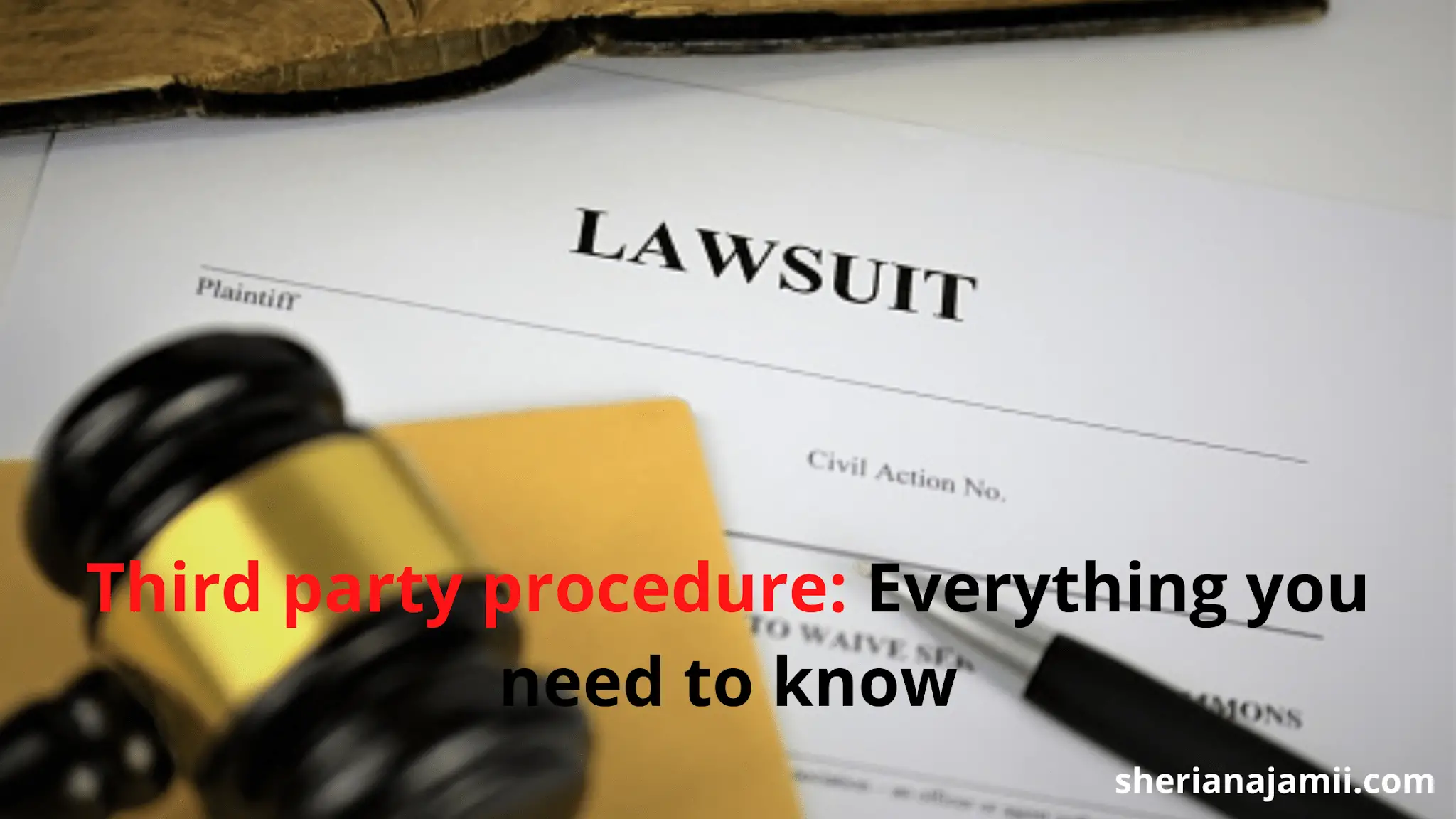This is a guide to a third-party procedure in civil law.
In this guide you will learn;
- meaning of the third-part procedure
- conditions for joining the third-party in a suit
- procedure for joining the third-party to a suit
- etc.
Let’s get started
Jump to section
- What is a third-party procedure?
- Conditions for Joining a Third Party to the Suit
- Procedure for Joining a Third Party Into the Suit
- Seek court leave to file a third-party notice
- An Order Granting Leave to Present a Third-Party Notice
- Dismissal of the Application for leave to present a third-party notice
- Persons to be served with the third part Notice
- Right of Defence by the Third Party
- Costs under Third-Party Procedure
- Time Limitation under Third-Party Procedure;
- Conclusion
What is a third-party procedure?
Transform Your Communication, Elevate Your Career!
Ready to take your professional communication skills to new heights? Dive into the world of persuasive business correspondence with my latest book, “From Pen to Profit: The Ultimate Guide to Crafting Persuasive Business Correspondence.”

What You’ll Gain:
Third-party procedure refers to the procedure in a civil suit whereby a defendant is given room to join another person who is not a party to suit as co-defendant into the suit on the grounds that he (the defendant) has a legally recognized claim against that other person called the Third-Party.
For example, a driver can join the insurance company as a party to the personal injury(accident) suit.
The procedure is true, a joinder of the defendant in disguise.
The law which governs the third-party procedure in Tanzania is the Civil Procedure Code [CAP 33 R: E 2019] under Order I rules 14-23.
The main purpose of the third-party procedure is to prevent a multiplicity of actions. That means instead of the defendant suing the third party in a separate suit that consists of a similar course of action, the law allows him to join that third party in the present suit.
Conditions for Joining a Third Party to the Suit
According to Order 1 Rule 14 of Cap. 33, a defendant in a suit shall not exercise the option to join any person as a Third-Party into the suit unless the following facts exist cumulatively.
- That the person to be joined is indeed not a party to the suit.
- That the defendant who wants to join such another person (Third-party) claims for the third party.
- That the defendant claims from the third party for any contribution or indemnity.
- That the claim by the defendant is related to or connected with the subject matter of the suit and substantially the same as a relief or remedy claimed by the plaintiff.
Procedure for Joining a Third Party Into the Suit
Seek court leave to file a third-party notice
The defendant who wants to join a third party in the suit must first apply to the court for and obtain leave to present to the court a third-party notice before he is successful in the mission.
The application for leave follows the traditional tune of filling a chamber summons supported by an affidavit.
This application must be ex-parte unless the court otherwise directs.
Contents of an Affidavit Supporting an Application for Leave to Present a Third-Party Notice
An affidavit supporting the application for leave to present a third-party notice must, according to Order 1 rule 14 (2) of Cap. 33 contain the following facts;
- The nature of the claim made by the plaintiff in the suit;
- The stage which the proceedings in the suit have reached;
- The nature of the claim made by the applicant against the third party and its relationship to the plaintiff’s claim against the applicant (defendant); and
- The name and address of the third-party.
It is on these legal requirements that the court held in MANDANI v. SUCHALE [1971] HCD. 10 that an affidavit supporting an application for leave to present a third party notice must contain sufficient facts to prove that it is necessary to join the third party;
An Order Granting Leave to Present a Third-Party Notice
Once the court has been satisfied with the application, it may order the defendant to file his third-party notice as prayed.
Dismissal of the Application for leave to present a third-party notice
The defendant’s application to the court for leave to present a third-party notice is an application like any other application.
The defendant is not thus entitled to meander with the suit or to abuse the court process under the umbrella of the application.
In SLADE & KEMPTON (JEWELLERY) LTD v. N KAYMAN LTD LEROY (THIRD PARTY); [1969] 3 ALL ER 786, For example, it was held that such an application may be dismissed for want of prosecution if the defendant unreasonably delays it;
It must also be noted here that, generally a court of law has powers to dismiss any proceedings filed with the intent to abuse the court process; see EZEKIEL B. CHENGE v. ADAM KAITA HC. CIV. CASE NO; 40 of 1998 AT MWANZA (unreported)
Persons to be served with the third part Notice
The third-party notice so presented must be served to all the parties to the suit including the third party himself, it is served as if it is a pleading, and it must be signed by the Judge or Magistrate or any authorized officer and shall be sealed with the seal of the court.
Certainly, the normal procedure of service of summons applies to this notice. (Order 1 rule 16 read together with Order V rule 2 of Cap. 33)
Right of Defence by the Third Party
Upon receipt of the notice, the third party may exercise any of two options if he objects to the claim; he may directly file a defense disputing the plaintiff’s claim or he may file a defense against the defendant’s claim (who presented the notice).
He must exercise either of the two options within 21 days from the service of the notice or within the period that the court will provide (Order 1 Rule 17 of Cap. 33)
Costs under Third-Party Procedure
As it is in the normal conduct of cases, the court is clothed with powers to decide all questions of costs between a third party and other parties to the suit, under the circumstances it may make such orders as to costs as it may think just [Order I rule 20].
These powers of the court should be considered together with the general powers in respect of costs under S. 30 of Cap. 33.
The main legal principle propounded by the Court of Appeal in the case of NJORO FURNITURE MART LTD v TANZANIA ELECTRIC SUPPLY CO LTD 1995 TLR 205 in respect of costs is also to be kept in mind, in this decision the Court held thus;
Costs follow the event; where the court directs that any costs shall not follow the event the court shall state its reasons in writing”
Time Limitation under Third-Party Procedure;
According to Order, I rule 20, the limitation of time as provided for by the Civil Procedure Code, Cap. 33 and the Law of Limitation Act, Cap. 89 apply mutatis mutandis to the third-party procedure as provided for under Order I rules 14, 15, 16, 17, 18, and 19.
Under these instructions of the law, therefore, the limitation of time in respect of the third-party procedure applies as if;
- The third-party notice was a summons to defend;
- The defendant presenting the notice was a plaintiff and the third party was a defendant;
- The date fixed for the giving of the direction was a date fixed for the hearing of a suit.
- Judgment entered against the third party in accordance with the provisions of rule 19 was an ex parte judgment entered against a defendant in a suit
Conclusion
My aim here was to share with you all the basic things you need to know about the third-party procedure. I urge you to read the relevant provisions of the law governing the third-party procedure as cited above for further insights.




